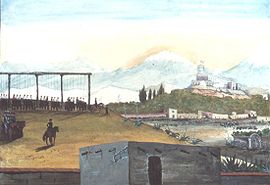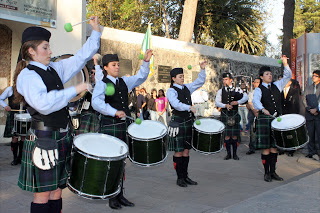
Mona AlvardoFrazier
Editor’s note: A timely re-posting of a 2013 column by Mona AlvaradoFrazier. Amigos publications wire report.
By Mona AlvaradoFrazier / Guest contributor
In my family we have a cousin born on St. Patrick’s Day and nieces of Irish and Mexican heritage, one who is named Erin. My mother’s been to Ireland and every St. Patty’s Day she enjoys the traditional Irish dish of corned beef and cabbage at the local Irish pub.
We’re from Southern California, so what is it about St. Patrick’s Day that resonates with Latinos, especially Mexican’s and those of Mexican heritage?
The answer is a little more complex than green beer and green Margaritas. The Irish and Mexican share values of family, work ethic, Catholicism, the love of music, poetry, and we share a war. Yes, a shared war.

Erin go Bragh is most often translated as “Ireland Forever”
The Mexican American War of 1846-48 had an infantry and artillery unit of Irishmen, formed by John Riley. He formed the Saint Patrick’s Battalion, or as the Mexican soldiers called them, Los Colorados Valientes (The Valient Reds) or Los San Patricios (The Saint Patricks). The latter named stuck.
Los San Patricios, led by Juan Reley (the name he enrolled into the Mexican Army) began with 175 immigrant Irish, German, English, French, and escaped African slaves from the southern USA and grew to more than 700 men, the majority immigrants from Ireland.
The brigade gained men as more of them became disenfranchised from the U.S Army. Theories for desertion included mistreatment of immigrant soldiers, inability to practice Catholicism, and cultural alienation. There was also the incentive of higher wages and the promise of land.
 Many of these soldiers, like John Riley, identified with the Mexican people. He was shocked at the behavior of the Texas Rangers and U.S commanding officers who robbed, raped and murdered and who desecrated Catholic churches in Mexico.
Many of these soldiers, like John Riley, identified with the Mexican people. He was shocked at the behavior of the Texas Rangers and U.S commanding officers who robbed, raped and murdered and who desecrated Catholic churches in Mexico.
Riley realized that the U.S reason for war was one of conquest; the Mexican’s reason, one of liberty from foreign intruders.
While held prisoner in Mexico City, Riley wrote to a friend in Michigan:
“Be not deceived by a nation that is at war with Mexico, for a friendlier and more hospitable people than the Mexicans there exists not on the face of the earth.”
Los San Patricios, when captured by the U.S. Army, were treated and punished as traitors. Seventy-two men went through a court martial in Mexico by the U.S. None of the men were represented by lawyers, and there are no transcripts of the proceedings. All were sentenced to death by hanging.
By order of Gen. W. Scott 30 San Patricios were executed at Chapultepec, Mexico City in full view of the two armies who had fought there, at the precise moment that the flag of the U.S. replaced the flag of Mexico atop the citadel.

Courtesy image showing the execution of members of Los San Patricios outside Chapultepec Castle.
At the moment of the intended replacement, military cadet Juan Escutia wrapped himself in the Mexican flag and leapt to his death from Chapultepec Castle to deny the Americans the honor of capturing it. The cadet is honored as one of Los Niños Heroes.
In a final act of defiance, Los San Patricios about to be hanged cheered the Mexican flag, as one onlooker remarked: “Hands tied, feet tied, their voices still free”
The Americans considered Los San Patricios traitors, the Mexicans consider them brave heroes who came to their aid.
Many of the surviving Los San Patricios disappeared from history although a handful are on record as having received the land promised to them by the Mexican government.
The men have continued to be honored and revered as heroes in Mexico. The Batallón de San Patricio is memorialized on two separate days: Sept. 12, the generally-accepted anniversary of the executions of those convicted by the U.S. Army of desertion at time of war, and March 17, Saint Patrick’s Day.

Courtesy image of youth performing during a St. Patrick’s Day celebration.
Numerous schools, churches and other landmarks in Mexico take their name from the battalion, including:
- Monterrey — The street in front of the Irish School is named Batallón de San Patricio (“Battalion of Saint Patrick”).
- The St. Patrick’s Battalion Pipes & Drums or “Banda de Gaitas del Batallon de San Patricio.” (visit their FB page).
- Mexico City — The street named Mártires Irlandeses (“the Irish martyrs”).
- The coastal town of San Patricio, Jalisco.
- The battalion’s name is written in gold letters in the chamber of Mexico’s House of Representatives.
- A Mexican soccer team named The Union Ultras, formerly known as St. Patrick’s battalion.
- Los San Patricios were evoked in a St. Patricks day message by Subcommandante Marcos, leader of the Zapatista Army of National Liberation.
In 2004, at an official ceremony attended by numerous international dignitaries including directors Lance and Jason Hool, as well as several actors from the film One Man’s Hero* (1999), the Mexican government gave a commemorative statue to the Irish government in perpetual thanks for the bravery, honor and sacrifice of the Saint Patrick’s Battalion.
The statue was erected in Clifden, Connemara, Ireland, where leader Jon Riley was born. In honor of Jon Riley, on Sept. 12 the town of Clifden flies the Mexican flag.
So in honor of the bravery and sacrifice of Los San Patricios, let’s remember them on Saint Patrick’s Day with the wearing of the green and listening to a rendition of Danny Boy, Latino style, by musician Ruben Blades and his wife, opera star, Luba Mason.
* One Man’s Hero starring Tom Berenger, a Paramount film, is the best known of the 8-10 movies made about the participation of the San Patricio Battalion in the Mexican American War.
— Mona AlvaradoFrazier is a writer. To see more of her work, visit http://www.alvaradofrazier.com
